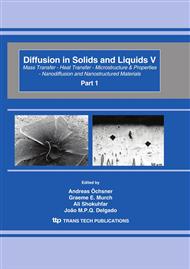p.820
p.826
p.832
p.838
p.844
p.849
p.853
p.859
p.864
Thermal Expansion of Advanced Materials for High Temperature Fusion Application
Abstract:
In this paper, two different technologies for preparation of the composite are presented: vacuum diffusion bonding and gas pressure infiltration. Samples contained different volume fractions of tungsten fibres (10%, 50% and 78%) that were arranged in unidirectional, cross-ply and circular architecture. The coefficient of thermal expansion (CTE) of Cu/W MMC samples was measured in the longitudinal and transverse direction to the fibre orientation and it strongly depended on arrangement of reinforcing phase and direction of measurement. For the unidirectional material the CTE was 4 - 6 ppm.K-1 and 11-12 ppm.K-1 in directions parallel and transverse to the fibre orientation, respectively. Samples in a shape of a ring contained reinforcement that was wounded around the sample centre (circumferential winding) or was cut-out from the Cu/W MMC plate. In the second case, the reinforced fibres had the woven arrangement. The CTE of ring measured in radial direction showed values from 5 ppm.K-1 to 20 ppm.K-1 for composites containing 72 and 10 vol. % of W-fibres, respectively.
Info:
Periodical:
Pages:
844-848
Citation:
Online since:
April 2010
Authors:
Price:
Сopyright:
© 2010 Trans Tech Publications Ltd. All Rights Reserved
Share:
Citation:


